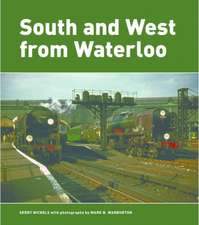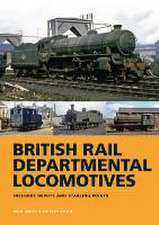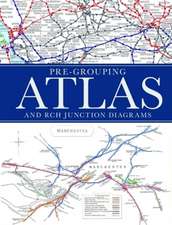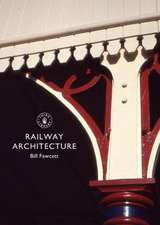The Iron Horse and the Windy City: How Railroads Shaped Chicago
Autor David M. Youngen Limba Engleză Hardback – 18 mai 2005
With the coming of railroads, upstart Chicago quickly became the Midwest's center for commerce and trade, overtaking its older rival, St. Louis. The first tracks to link the East coast with the West ran through Chicago, and within a few decades the city grew to be the hub of an immense transportation network that stretched across the nation.
Noted transportation writer David M. Young vividly tells how railroads created and shaped Chicago, from the earliest times to the present. He shows how the expansion of rail lines promoted the growth of the suburbs, and how Chicago's burgeoning manufacturing hub became home to such corporate giants as Cyrus McCormick's harvester operation and catalogue houses Montgomery Ward; Spiegel; and Sears, Roebuck and Company. For the most part, the railroad companies that schemed to bypass Chicago failed.
As the hub of a vast transportation network, Chicago experienced many tragic accidents at rail crossings. One of the first books to deal with the history of accidents and issues of safety, The Iron Horse and the Windy City reveals how Chicago eventually forced railroad companies to eliminate dangerous crossings by installing barriers or by raising tracks above street level.
Railroad magnates, entrepreneurs, and ordinary people come to life in this first comprehensive account of the impact of railroads on Chicago. Transportation historians and general readers interested in Chicago will find it both essential and engaging.
Noted transportation writer David M. Young vividly tells how railroads created and shaped Chicago, from the earliest times to the present. He shows how the expansion of rail lines promoted the growth of the suburbs, and how Chicago's burgeoning manufacturing hub became home to such corporate giants as Cyrus McCormick's harvester operation and catalogue houses Montgomery Ward; Spiegel; and Sears, Roebuck and Company. For the most part, the railroad companies that schemed to bypass Chicago failed.
As the hub of a vast transportation network, Chicago experienced many tragic accidents at rail crossings. One of the first books to deal with the history of accidents and issues of safety, The Iron Horse and the Windy City reveals how Chicago eventually forced railroad companies to eliminate dangerous crossings by installing barriers or by raising tracks above street level.
Railroad magnates, entrepreneurs, and ordinary people come to life in this first comprehensive account of the impact of railroads on Chicago. Transportation historians and general readers interested in Chicago will find it both essential and engaging.
Preț: 428.94 lei
Nou
Puncte Express: 643
Preț estimativ în valută:
82.08€ • 85.93$ • 67.91£
82.08€ • 85.93$ • 67.91£
Carte tipărită la comandă
Livrare economică 07-21 aprilie
Preluare comenzi: 021 569.72.76
Specificații
ISBN-13: 9780875803340
ISBN-10: 0875803342
Pagini: 280
Dimensiuni: 216 x 279 x 25 mm
Greutate: 1.13 kg
Ediția:1
Editura: Northern Illinois University Press
Colecția Northern Illinois University Press
ISBN-10: 0875803342
Pagini: 280
Dimensiuni: 216 x 279 x 25 mm
Greutate: 1.13 kg
Ediția:1
Editura: Northern Illinois University Press
Colecția Northern Illinois University Press
Recenzii
"A fine book, worth the attention of any serious historian of the railroad industry."—Journal of Illinois History
"David M. Young enriches and expands upon our historical knowledge of Chicago by illuminating the centrality of railroading in the city's ascent. This book, in the company of Young's earlier studies about the city's transportation history, will rightfully assume an indispensable place on readers' bookshelves."—Michael H. Ebner, author of Creating Chicago's North Shore
"In this nicely crafted work, David Young takes the reader on a fascinating tour of the past and present of railroads in Chicagoland. This book is remarkably informative and offers lively reading. No one has ever done this topic so well."—H. Roger Grant, author of The North Western
"David M. Young enriches and expands upon our historical knowledge of Chicago by illuminating the centrality of railroading in the city's ascent. This book, in the company of Young's earlier studies about the city's transportation history, will rightfully assume an indispensable place on readers' bookshelves."—Michael H. Ebner, author of Creating Chicago's North Shore
"In this nicely crafted work, David Young takes the reader on a fascinating tour of the past and present of railroads in Chicagoland. This book is remarkably informative and offers lively reading. No one has ever done this topic so well."—H. Roger Grant, author of The North Western
Notă biografică
David M. Young, former transportation editor for the Chicago Tribune, is author of several books on transportation in Chicago, including Chicago Transit.
Cuprins
Table of Contents
Preface
Introduction
1. Before the Iron Horse
2. Arrival of the Railroads
3. Critical Mass
4. Bypassing Chicago
5. Shaping Chicago
6. The Suburbs
7. Travelers and Terminals
8. The Bottleneck
9. The Railroad Supply Industry
10. Dominance, Reform, and Regulation
11. Railroad Crossings
12. Decline and Decentralization
13. Liquidation, Consolidation, and Diversification
14. Redevelopment
Epilogue
Appendix A Suburban Population Growth, 1850-1900
Appendix B Suburban Population Growth, 1900-2000
Appendix C Railroad Disasters
Notes
Selected Bibliography
Index
Introduction
1. Before the Iron Horse
2. Arrival of the Railroads
3. Critical Mass
4. Bypassing Chicago
5. Shaping Chicago
6. The Suburbs
7. Travelers and Terminals
8. The Bottleneck
9. The Railroad Supply Industry
10. Dominance, Reform, and Regulation
11. Railroad Crossings
12. Decline and Decentralization
13. Liquidation, Consolidation, and Diversification
14. Redevelopment
Epilogue
Appendix A Suburban Population Growth, 1850-1900
Appendix B Suburban Population Growth, 1900-2000
Appendix C Railroad Disasters
Notes
Selected Bibliography
Index
Descriere
With the coming of railroads, upstart Chicago quickly became the Midwest's center for commerce and trade, overtaking its older rival, St. Louis. The first tracks to link the East coast with the West ran through Chicago, and within a few decades the city grew to be the hub of an immense transportation network that stretched across the nation.
Noted transportation writer David M. Young vividly tells how railroads created and shaped Chicago, from the earliest times to the present. He shows how the expansion of rail lines promoted the growth of the suburbs, and how Chicago's burgeoning manufacturing hub became home to such corporate giants as Cyrus McCormick's harvester operation and catalogue houses Montgomery Ward; Spiegel; and Sears, Roebuck and Company. For the most part, the railroad companies that schemed to bypass Chicago failed.
As the hub of a vast transportation network, Chicago experienced many tragic accidents at rail crossings. One of the first books to deal with the history of accidents and issues of safety, The Iron Horse and the Windy City reveals how Chicago eventually forced railroad companies to eliminate dangerous crossings by installing barriers or by raising tracks above street level.
Railroad magnates, entrepreneurs, and ordinary people come to life in this first comprehensive account of the impact of railroads on Chicago. Transportation historians and general readers interested in Chicago will find it both essential and engaging.
Noted transportation writer David M. Young vividly tells how railroads created and shaped Chicago, from the earliest times to the present. He shows how the expansion of rail lines promoted the growth of the suburbs, and how Chicago's burgeoning manufacturing hub became home to such corporate giants as Cyrus McCormick's harvester operation and catalogue houses Montgomery Ward; Spiegel; and Sears, Roebuck and Company. For the most part, the railroad companies that schemed to bypass Chicago failed.
As the hub of a vast transportation network, Chicago experienced many tragic accidents at rail crossings. One of the first books to deal with the history of accidents and issues of safety, The Iron Horse and the Windy City reveals how Chicago eventually forced railroad companies to eliminate dangerous crossings by installing barriers or by raising tracks above street level.
Railroad magnates, entrepreneurs, and ordinary people come to life in this first comprehensive account of the impact of railroads on Chicago. Transportation historians and general readers interested in Chicago will find it both essential and engaging.








